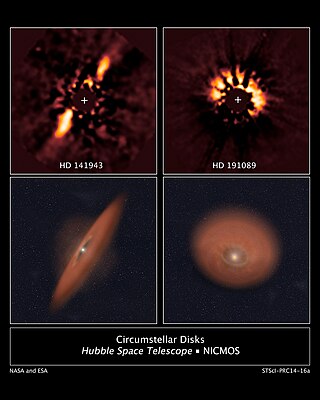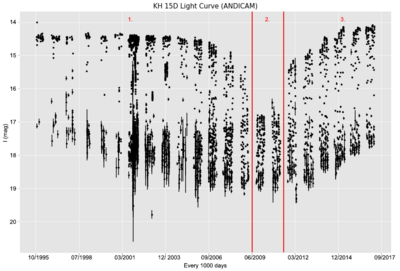
T Tauri is a variable star in the constellation Taurus, the prototype of the T Tauri stars. It was discovered in October 1852 by John Russell Hind. T Tauri appears from Earth amongst the Hyades cluster, not far from ε Tauri, but it is actually 420 light-years behind it and not a member of the cluster. The cloud to the west of the system is NGC 1555, known more commonly as Hind's Variable Nebula.

Beta Trianguli is the Bayer designation for a binary star system in the constellation Triangulum, located about 127 light years from Earth. Although it is only a third-magnitude star, it is the brightest star in the constellation Triangulum.

42 Capricorni is a binary star system in the zodiac constellation of Capricornus. It has a combined apparent visual magnitude of 5.18, so it is faintly visible to the naked eye. Its annual parallax shift of 30.09 mas yields a distance estimate of about 108 light years; the system is moving closer to the Sun with a radial velocity of −1.2 km/s. 42 Capricorni is 0.2 degree south of the ecliptic and so is subject to lunar occultations.

A debris disk, or debris disc, is a circumstellar disk of dust and debris in orbit around a star. Sometimes these disks contain prominent rings, as seen in the image of Fomalhaut on the right. Debris disks are found around stars with mature planetary systems, including at least one debris disk in orbit around an evolved neutron star. Debris disks can also be produced and maintained as the remnants of collisions between planetesimals, otherwise known as asteroids and comets.
HD 98800, also catalogued as TV Crateris, is a quadruple star system in the constellation of Crater. Parallax measurements made by the Hipparcos spacecraft put it at a distance of about 150 light-years away, but this value is in high error. The system is located within the TW Hydrae association (TWA), and has received the designation TWA 4.

HR 5553 is a binary star system located thirty-eight light-years away from the Sun, in the northern constellation Boötes. It has the variable star designation DE Boötis, and is classified as an RS Canum Venaticorum variable that ranges in apparent visual magnitude from 5.97 down to 6.04, which is bright enough to be dimly visible to the naked eye. The system is drifting closer to the Sun with a radial velocity of −30 km/s, and is expected to come as close as 26.9 light-years in 210,000 years.

A circumbinary planet is a planet that orbits two stars instead of one. The two stars orbit each other in a binary system, while the planet typically orbits farther from the center of the system than either of the two stars. In contrast, circumstellar planets in a binary system have stable orbits around one of the two stars, closer in than the orbital distance of the other star. Studies in 2013 showed that there is a strong hint that a circumbinary planet and its stars originate from a single disk.
Zeta Horologii, Latinized from ζ Horologii, is a yellow-white-hued binary star system in the southern constellation of Horologium. It is visible to the naked eye with a combined apparent visual magnitude of 5.20. Based upon an annual parallax shift of 20.37 mas as seen from Earth, it is located around 160 light-years from the Sun.

A circumstellar disc is a torus, pancake or ring-shaped accretion disk of matter composed of gas, dust, planetesimals, asteroids, or collision fragments in orbit around a star. Around the youngest stars, they are the reservoirs of material out of which planets may form. Around mature stars, they indicate that planetesimal formation has taken place, and around white dwarfs, they indicate that planetary material survived the whole of stellar evolution. Such a disc can manifest itself in various ways.

GG Tauri, often abbreviated as GG Tau, is a quintuple star system in the constellation Taurus. At a distance of about 450 light years away, it is located within the Taurus-Auriga Star Forming Region. The system comprises three stars orbiting each other in a hierarchical triple system, known as GG Tauri A, and another binary star system more distant from the central system, known as GG Tauri B.

GW Orionis is a T Tauri type pre-main sequence hierarchical triple star system. It is associated with the Lambda Orionis star-forming region and has an extended circumtrinary protoplanetary disk.

A circumplanetary disk is a torus, pancake or ring-shaped accumulation of matter composed of gas, dust, planetesimals, asteroids or collision fragments in orbit around a planet. Around the planets, they are the reservoirs of material out of which moons may form. Such a disk can manifest itself in various ways.

AK Scorpii is a Herbig Ae/Be star and spectroscopic binary star about 459 light-years distant in the constellation Scorpius. The star belongs to the nearby Upper Centaurus–Lupus star-forming region and the star is actively accreting material. The binary is surrounded by a circumbinary disk that was imaged with VLT/SPHERE in scattered light and with ALMA.

RW Aurigae is a young binary system in the constellation of Auriga about 530 light years away, belonging to the Taurus-Auriga association of the Taurus Molecular Cloud. RW Aurigae B was discovered in 1944.

RW Tauri is a binary star system in the equatorial constellation of Taurus. It has the designation HD 25487 in the Henry Draper Catalogue, while RW Tauri is the variable star designation. With a peak apparent visual magnitude of 8.05, it is too faint to be visible to the naked eye. The distance to this system is approximately 940 light years based on parallax measurements.

CQ Tauri is a young variable star in the equatorial constellation of Taurus. It is too faint to be visible to the naked eye with an apparent visual magnitude that ranges from 8.7 to 12.25. The distance to this star is approximately 487 light years based on parallax measurements, and it is drifting further away with a radial velocity of ~23 km/s. It appears to be part of the T-association Tau 4. CQ Tauri lies close enough to the ecliptic to undergo lunar occultations.

DW Ursae Majoris is an eclipsing binary star system in the northern circumpolar constellation of Ursa Major, abbreviated DW UMa. It is a cataclysmic variable of the SX Sextanis type, consisting of a compact white dwarf that is accreting matter from an orbiting companion star. The brightness of this source ranges from an apparent visual magnitude of 13.6 down to magnitude 18, which is too faint to be viewed with the naked eye. The distance to this system is approximately 1,920 light years based on parallax measurements.

V773 Tauri is a young, multiple star system in the central region of Taurus, an equatorial constellation. This is a T Tauri-type variable star that ranges in apparent visual magnitude from 10.59 down to 10.95, which is too faint to be viewed with the naked eye. Based on various estimates, the system is located at a distance of approximately 433 light years from the Sun. It lies near the dark cloud Lynds 1495.


















